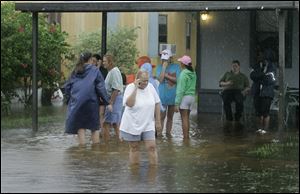
Dangers rise as Fay socks Florida again
8/22/2008
Residents of a mobile home park in Melbourne, Fla., await help. Authorities in some areas used canoes, airboats, and Humvees to rescue people stranded by the flooding.
MELBOURNE, Fla. - As if a fourth straight day of rain from Tropical Storm Fay wasn't enough, residents are now dealing with quintessentially Floridian fallout: alligators, snakes, and other animals driven from their swampy lairs into flooded streets and backyards.
National Guardsman Steve Johnson was wading through hip-deep water Wednesday night when his flashlight revealed an alligator drifting through a neighborhood of flooded mobile homes.
"I said, 'What the heck is that?' and there was an alligator floating by," he said.
"I took my flashlight and was like, 'You've got to be kidding me, a big old alligator swimming around here,'•" he said.
The erratic and stubborn storm has dumped more than 2 feet of rain along parts of Florida's low-lying central Atlantic coast this week.
The system continued its slow, wet march yesterday by curving back from the ocean to hit the state for a third time.
Since making its first landfall in Key West Monday, Fay zig-zagged through the state, dropping up to 30 inches of rain in some Central Florida areas and carrying 60 mph winds.
The deluge caused catastrophic flooding that officials estimated would cause millions of dollars of damage to buildings, homes, infrastructure, and agriculture.
Fay, which was responsible for at least 23 deaths in the Caribbean and two in Florida, is just the fourth storm in recorded history to hit the Florida peninsula with tropical storm intensity three separate times. The most recent was Hurricane Donna in 1960, according to Daniel Brown, a specialist at the National Hurricane Center.
Florida National Guard troops and local authorities had to rescue stranded people with canoes, airboats, and Humvees.
"I'm flabbergasted," Port St. Lucie resident Kara Trigo, 29, said of the high water. "The police were on airboats. The catfish are crossing the roads."
By afternoon, Federal Emergency Management Agency workers had been dispatched to survey the hardest hit areas.
"I didn't expect to see this much," FEMA spokesman Jeff Walsh said after visiting Lamplighter, Fla. "There was no section that wasn't flooded, some higher than others."
Forecasters expect Fay to gradually weaken as it moves west across North Florida through Sunday. By then, the storm will have soaked every inch of the state.
Alligators live in all 67 Florida counties and state officials say they receive more than 18,000 alligator-related complaints each year. But the floodwaters heighten the risk of an encounter with people because the creatures search for a safe place to wait out the storm.
"They are trying to find dry land, someplace to hide," said officer Lenny Salberg of the Florida Fish and Wildlife Commission.
The threat of alligators, snakes, and other creatures is one more problem confronting weary residents as they clean up their waterlogged homes. At least two alligators were captured in residential neighborhoods and several others were spotted near homes.
In Carla Viotto's backyard in Indialantic, outside of Melbourne, snakes were swimming around in 4 inches of water.
"It looked just like a junk yard," she said.
Flooding was especially acute along the Atlantic coast from Port St. Lucie to Cape Canaveral, with water reaching depths of 5 feet in some neighborhoods. Gov. Charlie Crist visited the area yesterday and President Bush issued a federal disaster declaration for the affected parts of Florida to help with the storm's costs.
Brevard County officials estimated building damage would cost $12 million, mostly from flooding, and $2.6 million in damage from beach erosion.
"This is the worst I've absolutely ever seen it," said Mike White, 57, who was rescued by the National Guard as water crept up to the door of his mobile home.
Police said an Indiana tourist drowned after going swimming in rough waters churned up by the storm at Neptune Beach. To the south in Volusia County, authorities reported a second woman also drowned in Fay-generated waves.
Flooding was also possible in Georgia, where the southern half of the state's Atlantic coastline was under a tropical storm warning. Some parts of Georgia could get up to 6 inches of rain.
In the town of St. Marys, Mary Neff watched the rain from the Spencer House Inn, which she owns with her husband.
"We're pulling in our plants and porch furniture, making sure we have our supplies and gas for the generator," said Ms. Neff, who had three couples cancel weekend reservations. "I still think we all need to stay on our toes."